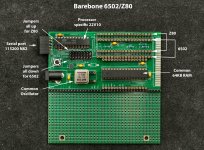Hugo Holden
Veteran Member
On the other hand if you are already good at programming and its electronic construction etc, you could really start with any kind of electronics project, it wouldn't even have to be a computer, it could be practically anything in the field, some computer test gear, audio & video amplifier kits etc build up your soldering , de-soldering and electrical and mechanical construction skills, the World is your oyster. A good project would be something that could help fix computers too, like a logic probe.Hi All,
I was wanting to build a kit for either a 6800, 6502, or 8080 CPU and wondering if anyone had any recommendations for a beginner? Beginner in terms of electrical engineering experience, definitely comfortable with programming just not verse in the ways of doing my own electronics. Was hoping I could start with a simple kit and go from there?
Thanks,
Chris
Last edited:



